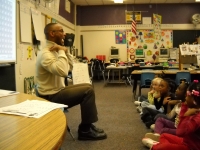Division (Into Groups) Multiplies Learning

Understanding fractions is useful in keeping track of Malik Daniel’s first grade math class at Roxboro Elementary School, with students divided into many small groups and lessons divided into many activities.
The district’s elementary math framework devotes 90 minutes to math each day, divided into segments, including whole-class and small group instruction, plus time for partner and individual activities. Thoughtful lesson planning allows teachers to differentiate activities to meet a range of student proficiency levels.
One a recent afternoon, Mr. Daniels’s first graders sit on the carpet for the day’s whole group lesson on numbers, which calls for lots of thinking, chanting and gestures. One student uses the Smart Board to add a sunny day to the weather graph. After counting the yellow suns, everyone spreads-out to do five jumping jacks. The students count by twos, snapping fingers and clapping when they called out 10 and 20.
Students complete a worksheet on counting pennies as Mr. Daniels moves into small-group instruction. Something similar is happening in Melissa Garcar’s fifth grade classroom.
Whole-class instruction is over and students break into small groups, based on the previous week’s short cycle assessment, which allowed Mrs. Garcar to identify strengths and weaknesses that are common among the children. Every fifteen minutes students move to a different station and quickly settle into a new activity. Some students play math games with a partner. Mrs. Garcar works with groups of four students on rounding fractions to the nearest one-half. Others practice math facts using a small electronic Flashmaster that times them and gives immediate feedback on accuracy. A special education aide helps four students with exercises in their math workbooks. Activities reinforce and extend what has been taught in previous lessons so that each student’s specific needs are met.
